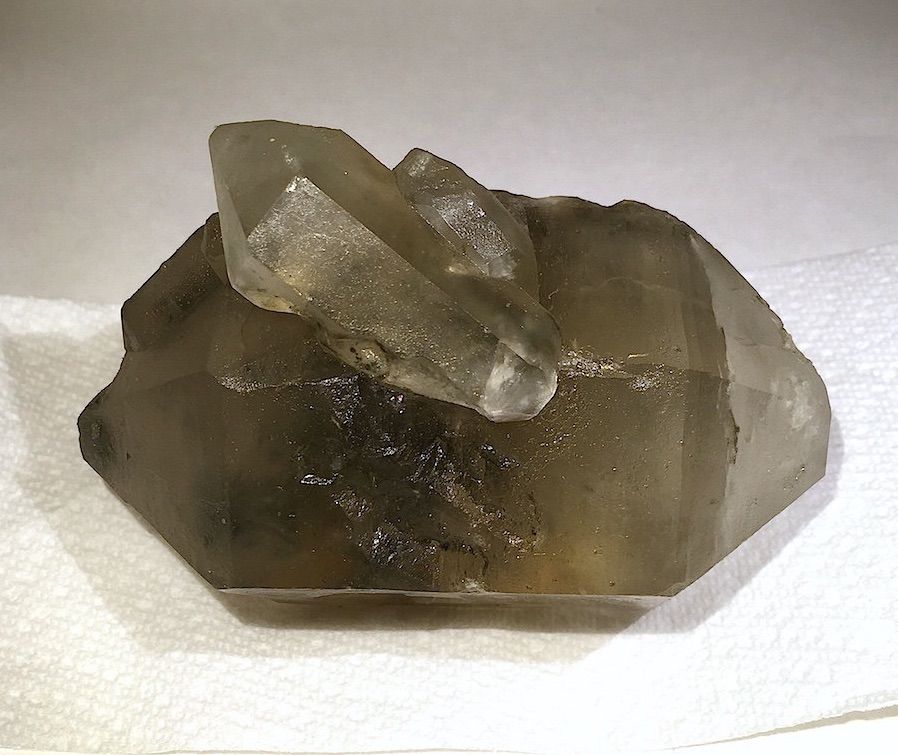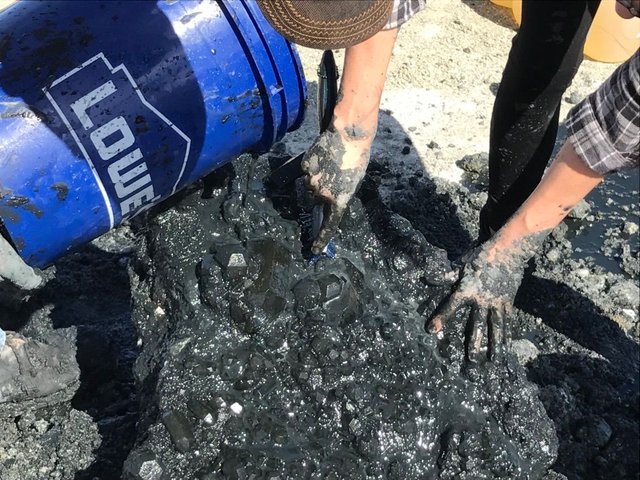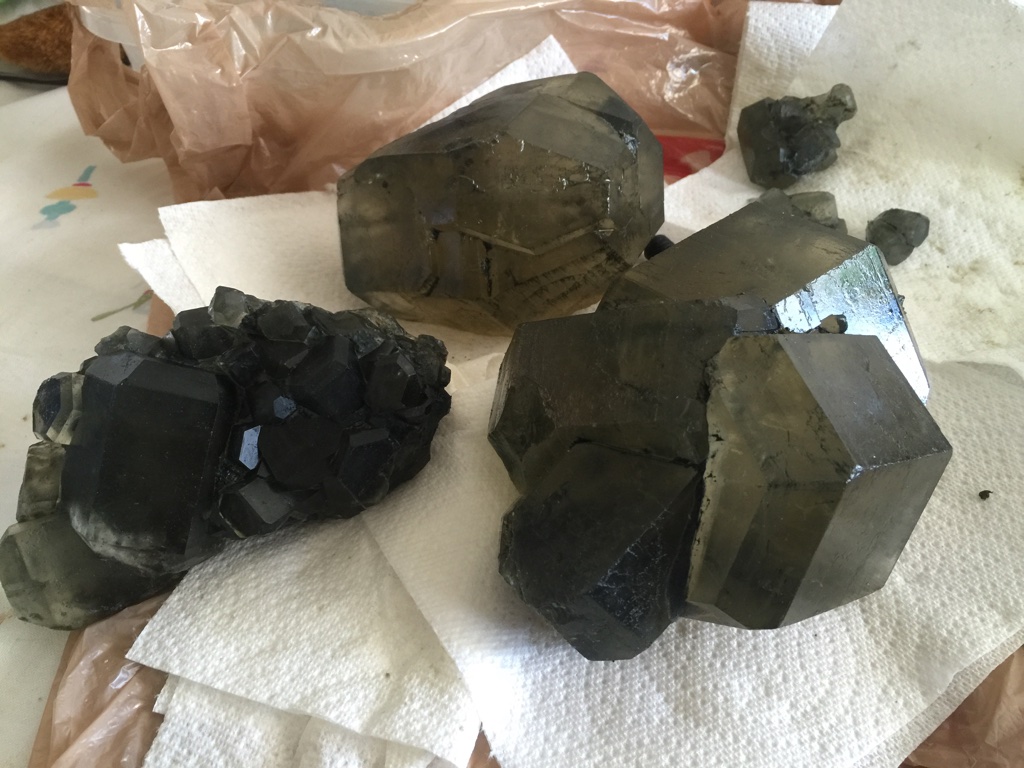Mineral Mondays #11: Hanksite
Hanksite
Hanksite is such a cool mineral. It forms large, fist to football sized crystals. Many people mistake it for quartz in photos, but it's very different in real life, let me explain.
Hanksite is a very rare mineral only found in a few places on earth, Argentina, China, Sweden and the US. It is a sulfate mineral with a twist, it also has carbonate making it one of only a few minerals that have both carbonate & sulfate ions. A sulfate is a salt of sulfuric acid. Don't worry, it won't hurt you.

I was introduced to hanksite by chance. One day my daughter came home from school and said "Dad, we have to go to this mineral show out in the desert!" The gem and mineral show she was referring to is called Gem-O-Rama and it is held every year during the second weekend of October in Trona, California near Death Valley. Her science teacher, Mr. Schinhoefen, told her about it and goes to the show every year. He encourages his students to attend as well and as fate would have it, we left early the next morning for what would be a life changing experience!
It was the event that started both my wife and I collecting gems and minerals. We had no idea what we were getting into at the time. We just thought it would be a nice trip to the desert for the kids to play in the dirt with some of their classmates, get them out into nature. Yet it would be mom and dad who would have the most fun! When we dug our first hanksite crystals we were hooked!

Hanksite grows in Searles lake. There are two types of hanksite, the common hanksite as shown in the first photo of this post and barrel hanksite shown in the photo above. The only difference is the crystal termination and the environment they grow in. The common hanksite grows in brine, ultra salty water, while barrel hanksite grows in a black, brine mud. I personally like the barrel hanksite better because of the clusters it grows in. It's also more fun trying to find them because you have to get dirty! I mean, real dirty. That mud is thick and messy and the only way to find the best crystals is to jump right in and use your hands to probe for the best crystals. That's me roughing it in the blue hat.
The one problem with barrel hanksite is it's usually cover in mud so you have to wash it with brine quickly, then store it in a cool, dry place away from the sun and water. Sunlight will bleach it and make it crack out. If it is exposed to water it will etch and dissolve. After you have washed it you should dry it and apply mineral oil to keep it from drying. If it is exposed to water it will etch and dissolve. The show provides troughs of brine to do the cleaning, but we also buy several liters of brine from the gem and mineral show and clean the crystals all night. It's exhausting work, but so worth it especially if we get a good crystal or cluster that can sell for upwards of $100.
Common hanksite is a much easier mineral to deal with. The Searles Valley Minerals Company, which owns the rights to the lake, drills holes in the lake bed about 40 feet down, sends explosive charges down to loosen the crystals, then pumps them up to the surface for everyone to collect. It comes out clean and with several other collectable minerals like sulphohalite, thenardite and halite.
Some Hanksite Facts:
- Hanksite is a sulfate mineral.
- Shape - hexagonal
- Composition - Na22K(SO4)9(CO3)2Cl
- Hardness - 3 - 3.5 (soft medium, diamond is 10)
- Refractive index (fire) - 1.481 - 1.55 (diamond is 2.417 - 2.419)
- Colors - black, brown, yellow, clear.
- Localities - mentioned, but best locality Trona, California
Barrel hanksite and common hanksite are collected on the same day at two different field trips onto the Searles' lake bed. These are the only times all year that hanksite can be collected, so you see a lot of people in the photos. Probably about 500-1000 people attend, many from all over the world.

What makes Searles lake special you might be thinking. It's unique because it is surrounded by mountains. There is no outlet, so the water and minerals drain into the lake and accumulate. This has been happening for tens of thousands of years. With so much saturation of salt in the lake these amazing crystals can grow both in size and quantity. It's also why Searles Lake is a major supplier of minerals to the rest of the world. It's minerals are used in many modern technologies including computers, LCDs and special coatings.
Here is a short video I made from 2016's show.
That's it for this week. If you would like to read more about the lake check out the Searles Valley Minerals' website: http://www.svminerals.com/default.aspx
For more information on Gem-O-Rama you can visit their website: http://www1.iwvisp.com/tronagemclub/GEM-O-RAMA.htm
Next Mineral Mondays #12: More Searles Lake Minerals Sulphohalite, Borax & Thenardite
- Follow me for stories on Japan, Gems & Minerals, Crypto, DnB, Cali & living life!
- Follow my wonderful wife for her adventures! @tokyowomanslife
Thanks for reading!
Our Steemit Blogger Central Discord community is here:

Discord:
https://discord.gg/e5XFZKa
Woah! That's so cool having rocks just lying around to pickup! I wish dad and I were as lucky - and as you say, dad likes messing around looking for stones on holidays.
I'm eagerly awaiting the posts about you and your father's gem hunting adventures!
wunderbarer Bericht
That is so cool! I'm quite envious of your knowledge and collecting experiences! Tip!
Ah, my knowledge is very shallow. I know enough to get me into trouble! Thanks.
I once went looking for Herkimer diamonds and garnets in NY state with a guy I knew, but that was as close as I ever got to being a rock hound and we ended up buying some at the rock shop! I do love rocks and minetals and wish I would have dedicated more time to learning more when I was younger.
It's never too late! The nice thing about rockhounding is anyone can do it just about anywhere in the states. You just have to know where to go. It also gets you out into nature which many of us need more of in the digital age.
When i was child , I went to mountain for dig out some stone with my father. Thank you for your explanation about beautiful stone jeiwery.
Now that you are older you should try it again!
Thank you for advice and comment.
Wow very nice post in best information . Thanks for sharing .
nice information
thank you so much
@rt395 Thank you for your work, I invite you to evaluate my work.
I'm a geology student, and I'd never even heard of hanksite before! I probably shouldn't be surprised at not knowing about an unusual mineral, though, given the crazy number of minerals in existence. Super cool stuff!
Being a geology student I'm sure you'd eventually get to it, especially learning about evaporite minerals of the mojave desert. And yes, tons of minerals!
Haven't spent a lot of time on basin geology yet- I'm up in Oregon, so focusing a lot more on volcanics, etc. Getting to basins this year, though!
We're lucky to be here out on the west coast with all this amazing geology. The cinder cones out in the Mojave always trip me out when I drive by them. Looking at google maps at the lava flows all over the place is cool too. Maybe in another life I would have been a geologist.
Enjoy your schooling!
I mean, it's never too late to start- there's several middle aged people in my program at school, and one guy in his 70s.
Hi @rt395! @melinda010100 is sending you 0.1 SBD tip and @tipU upvote :)
:)
@tipU - send tips by writing tip! in the comment, get share of the profit :)@originalworks
The @OriginalWorks bot has determined this post by @rt395 to be original material and upvoted it!
To call @OriginalWorks, simply reply to any post with @originalworks or !originalworks in your message!
To enter this post into the daily RESTEEM contest, upvote this comment! The user with the most upvotes on their @OriginalWorks comment will win!
For more information, Click Here! || Click here to participate in the @OriginalWorks writing contest!
Special thanks to @reggaemuffin for being a supporter! Vote him as a witness to help make Steemit a better place!